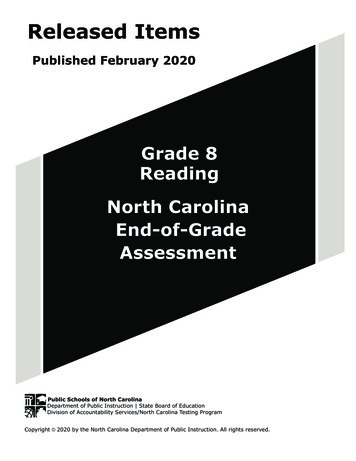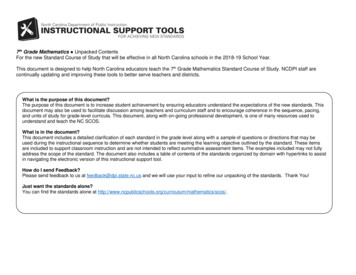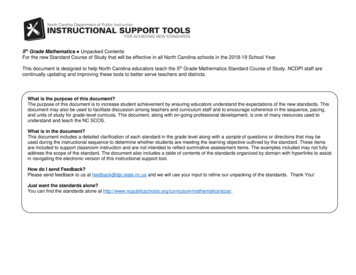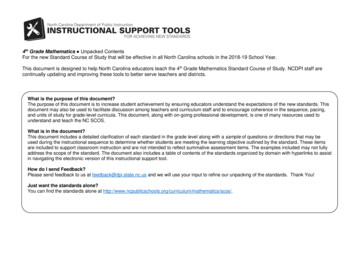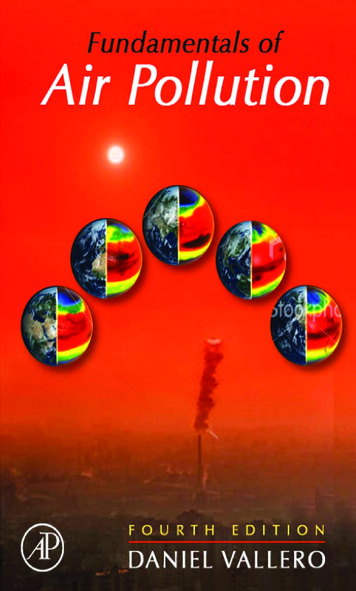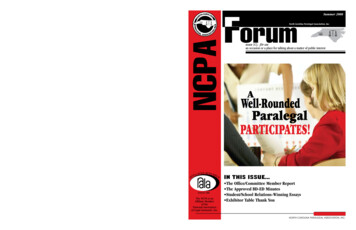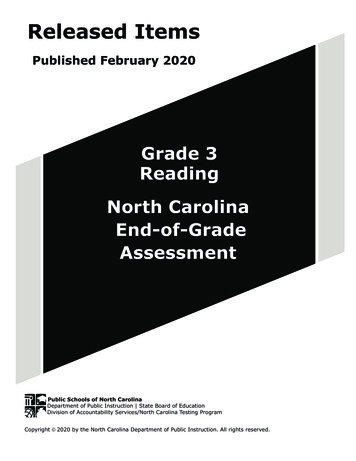
Transcription
Released ItemsPublished February 2020Grade 3ReadingNorth CarolinaEnd-of-GradeAssessmentPublic Schools of North CarolinaDepartment of Public Instruction State Board of EducationDivision of Accountability Services/North Carolina Testing ProgramCopyright ã 2020 by the North Carolina Department of Public Instruction. All rights reserved.
GRADE 3 READING—RELEASED ITEMSSample S2What does shy mean in the text?How many hearts does an octopus have?AoneBthreeCfiveDeightRS1DThe octopus is a sea animal. It has an interesting body. First, it has three hearts.The heart is often seen as a symbol of love. That’s a lot of love! An octopus also haseight limbs. Some people call them arms or tentacles. Eight arms could give a lot ofhugs, but the octopus is a very shy animal. If an octopus is scared, it will squirt inkand swim away.1
GRADE 3 READING—RELEASED ITEMSThe text below is divided into two parts. After each part are questions you willneed to answer.The Great Escape (Part 1)by Susan MitschDThe county was full of farms—farms here, farms there, farms everywhere. In the middleof the county fairgrounds sat the poultry tent. And in the middle of the poultry tent satRhode Island Red, the rooster.SEOne morning, Red pecked at the latch on his cage. No one noticed.He opened the door to his cage. No one noticed.EAHe hopped to the ground. No one noticed.He pecked open eight other cages. Eight chickens hopped out.A water boy noticed the chickens. “Hey! Stop!” he cried, and suddenly the chase was on!ELChickens ran this way; chickens flapped that way. The water boy called the feed boy.The feed boy called a farmer. The farmer called his wife. His wife called a poultry judge.Water, feed, and blue ribbons flew in the wind. Everyone tried to catch the chickens.RBut no one caught Rhode Island Red. He pecked at a dozen more latches. A dozen morehens flapped to freedom. He pecked at a dozen more latches! A dozen more roostersflapped away. Soon he had opened all the cages.People were shouting! Chickens were squawking! More people came running to see.Rhode Island Red headed straight for the goose tent. Soon one goose was loose. Thenanother. By the time anyone in that tent noticed, every goose was loose! They all joinedthe chickens and ran down the hill. Rhode Island Red ran in the lead, with the people inhot pursuit!The birds reached the goat barn. Soon Rhode Island Red had let every goat loose!Billies, nannies, and kids all joined in the party!Red ran on to the sheep building. Rams, lambs, and ewes all joined in the spree!2Go to the next page.
GRADE 3 READING—RELEASED ITEMSpokedBran fromCmarched toDtossedAsideBfenceClockDbottomSEDWhat is the meaning of latch in paragraph 2?EA3AWhat did Rhode Island Red do after he got out of his cage?AHe rode with the animals on the roller coaster.BHe put all of the animals in their cages.CHe chased the animals to the midway.DHe let the other animals out of their cages.EL2What is the meaning of pecked in paragraph 2?R13Go to the next page.
GRADE 3 READING—RELEASED ITEMSThe Great Escape (Part 2)by Susan MitschRed pecked open the pigpens and the cows’ gate. He pecked open the pony boxes andhorse stalls. Cows, pigs, and ponies joined the jamboree!Milkmaids and goatherds, trainers and shepherds, all chased after the animals.Rhode Island Red was leading them right to the midway!SEDThe animals ran this way and that through the rides. Chickens rode the Ferris wheel.Goats rode the roller coaster. Ponies rode the ponies on the merry-go-round! Geese atecotton candy. Pigs ate sweet corn, and sheep bobbed for apples at the apple-bobbingbooth! Cows rode the waterslide, and goats nibbled everything they could! Dust roseinto the air as people chased after the animals. No one would ever be able to catchthem all!Rattle! Rattle! Rattle! The sheep stopped. What was that sound?EAClink! Tink! Tink! The cows looked. They remembered that sound.Shake-a-shake-a-shake! The goats knew that sound. They came running to see whomade it.ELWalking straight down the busy midway was a boy shaking a pail full of oats. He knewjust what to do! He dropped a little trail of oats behind him as he walked. Rattle! Rattle!Rattle!RThe sheep, cows, and goats followed the boy’s trail of oats. The ponies jumped off themerry-go-round and sniffed after the sweet oats. The pigs followed, gobbling oatsgreedily. The chickens and geese pecked up oats, too. Rattle, rattle, shake-a-shake-ashake!The boy led the procession of hungry animals. And at the very end of the line, peckingup the yummy oats, was Rhode Island Red himself!Everyone cheered! The boy led the pigs to the pig building and the ponies to theirstalls. He took back the cows, sheep, and goats. He led the geese to their cages andthe chickens to their tent. And finally, the boy himself put away Rhode Island Red.And this last cage, he locked.4Go to the next page.
GRADE 3 READING—RELEASED ITEMS“You naughty rooster,” said the boy.But Rhode Island Red just drank a long drink, fluffed up his feathers, and crowed,“R-r-r-r-roooo!” Then he settled down to rest, looking very pleased with himself.He chased after each one to get them to run into their cages.BHe shook a pail of oats while yelling at the animals to get back intheir cages.CHe dropped a trail of oats behind him so the animals would followhim to their cages.DHe grabbed Rhode Island Red first and then scared all the other animalsto their cages.EASEDAWhich word describes the boy in the text?AcleverBscaredCunusualDuselessEL5How did the boy get all the animals back in their cages?R45Go to the next page.
GRADE 3 READING—RELEASED ITEMSUse both parts of this text to answer this question.Why is Rhode Island Red so pleased with himself at the end of the text?AHe gets the boy to feed all the animals and let them out of their cages.BHe gets all the animals back into their cages without anyone else’s help.CHe is happy to be in his cage with a long drink and some food.DHe is happy that he let the animals out of their cages so they could havesome fun.D6What is one way that Rhode Island Red and the boy are alike?They both lead the animals.BThey both chase the animals.CThey both feed the animals.DThey both catch the animals.EAAEL7SEUse both parts of this text to answer this question.Use both parts of this text to answer this question.Which statement from the text shows that Rhode Island Red is proud?R8A“And in the middle of the poultry tent sat Rhode Island Red, the rooster.”B“One morning, Red pecked at the latch on his cage.”C“Rhode Island Red headed straight for the goose tent.”D“But Rhode Island Red just drank a long drink, fluffed up his feathers, andcrowed, ‘R-r-r-r-roooo!’ ”6Go to the next page.
GRADE 3 READING—RELEASED ITEMSThe text below is divided into two parts. After each part are questions you willneed to answer.This text was published in 1996.Excerpt from Under My Nose (Part 1)by Lois EhlertDI never planned to be a writer, but something happened that changed my mind. Aboutten years ago I took a course to learn how to make handmade books. The books I madeneeded text, so I began writing words to go with my art. About the same time, I had anidea for a story about my garden.SESome friends and I shared a vegetable garden at the edge of the city of Milwaukee.I knew I could write about the vegetables and make sketches of them on the spot.They were right under my nose.EAThree years later, my book Growing Vegetable Soup was published. It was the first bookI illustrated and wrote.ELGetting a good idea for a book is the hardest thing for me, but also the most fun.Watching Milwaukee’s annual circus parade with its flashy colors and interesting animalsinspired the idea for my book Circus.RLiving close to Lake Michigan, I like to take long walks. One day while I was outside,a squirrel slipped inside my house through a torn window screen. That gave me theidea for a book. In Nuts to You! I tell how I got him out.When I write my books, I start with the picture first. Bucky, my sister’s cat, was mymodel for Feathers for Lunch. Before I wrote the story I measured his legs, his head,and his tail, and painted a life-size portrait of him. The story is about a cat trying tocatch a bird. That’s why I put the bell on his collar—it warns the birds. I added thewords “jingle, jingle” to go with my art.I began writing the story from the cat’s viewpoint. Later, I rewrote it from the catowner’s viewpoint.7Go to the next page.
GRADE 3 READING—RELEASED ITEMSEven when I get an idea for a book, it’s difficult for me to get started.Once I wanted to do a book about fish. I even had a title, Fish Eyes. To get myself in themood, I made a list of fishy words. I wondered how it would feel to swim like a fish.Could I put those feelings into words and pictures? I went to the aquarium and madesketches as I watched beautiful fish swim by. I read so much about fish that I felt fishwould swim out of my ears.startedCfinishedDusedDBSEchangedEAAAccording to the text, what is often difficult for the author?Adrawing picturesBcreating a titleCgetting startedDreading a bookEL10What is the meaning of inspired in paragraph 4?R98Go to the next page.
GRADE 3 READING—RELEASED ITEMSAlessonBpictureCreportDstoryThe bell warns the birds.BThe bell makes a nice sound.CThe bell is pretty.DThe bell is interesting.EASEADAccording to the text, why does the cat have a bell on its collar?EL12What is the meaning of portrait in paragraph 6?R119Go to the next page.
GRADE 3 READING—RELEASED ITEMSThis text was published in 1996.Excerpt from Under My Nose (Part 2)by Lois EhlertI like to write out rough story ideas for my books, then make thumbnail sketches.SEDNext, I make the dummy book.*EAI sketch in the art and hand-letter the words. I go over my dummy book with myeditor. I like to read the text out loud and listen to the rhythm of the words. The textand the art should help each other tell the story. I type the text on my typewriter inmy sunroom, where I’m surrounded by flowers, books, and plants. It’s quiet andpeaceful here, just the way I like it when I’m writing.RELFor my illustrations, I cut paper or material and glue the pieces to background paper.It’s the kind of thing I liked to do when I was growing up. The art technique is calledcollage. I used plain colored paper for Circus, Color Zoo, and Color Farm. ForRed Leaf, Yellow Leaf, and Snowballs I painted with watercolors and glued downreal objects. I cut and glued forty-three pieces of paper to make the pineapple forEating the Alphabet.When book ideas just won’t come, I stare out the window, water my plants, or go for awalk. I believe ideas need fresh air, too. I might wash my car, visit my mother, listen tothe radio and sing along, find another antique charm for my vest, or just sit and read.Then I sharpen my pencils and it’s back to work I go, trying to get those words andpictures to tell a story.As I go along, I continue to learn more about art and writing. If you like to write anddraw, I hope you will keep learning, too. Good luck and keep your eyes open. Theremight be a story right under your nose.*dummy book: small model of a book to show how the pages will be arranged10Go to the next page.
GRADE 3 READING—RELEASED ITEMSby contrasting two different styles for writing booksBby giving a step-by-step process for publishing a bookCby comparing the writing steps for two kinds of booksDby giving a chronological order for beginning a bookDHow does the author connect the ideas in paragraphs 12 and 13?by listing important events that have occurred in the author’s lifeBby explaining the different parts of the book that have to be madeCby describing how the author gets ideas when they just will not comeDby comparing the rhythm of the text when read aloud to how it lookson paperSEAEA15AWhat is the meaning of the phrase “right under your nose” in paragraph 16?EL14How does the author connect the writing steps in paragraphs 10 and 11?Ainside a personBon a person’s faceCread by a personDin front of a personR1311Go to the next page.
GRADE 3 READING—RELEASED ITEMSUse both parts of this text to answer this question.Which statement by the author supports the main idea?“The books I made needed text, so I began writing words to go with my art.”B“Getting a good idea for a book is the hardest thing for me, but also themost fun.”C“I like to write out rough story ideas for my books, then make thumbnailsketches.”D“I like to read the text out loud and listen to the rhythm of the words.”ELEASEDAR1612Go to the next page.
GRADE 3 READING—RELEASED ITEMSThe text below is divided into two parts. After each part are questions you willneed to answer.Adapted from The Adventures of Grandfather Frog:“Billy Mink Finds Little Joe Otter” (Part 1)by Thornton W. BurgessBilly Mink ran around the edge of the Smiling Pool and turned down by the LaughingBrook. His eyes twinkled with mischief, and he hurried as only Billy can. As he passedJerry Muskrat’s house, Jerry saw him.D“Hi, Billy Mink! Where are you going in such a hurry this fine morning?” he called.SE“To find Little Joe Otter. Have you seen him?” replied Billy.“No,” said Jerry. “He’s probably down to the Big River fishing. I heard him say last nightthat he was going.”EA“Thanks,” said Billy Mink, and without waiting to say more he was off like a little brownflash.ELJerry watched him out of sight. “Hump!” exclaimed Jerry. “Billy Mink is in a terrible hurrythis morning. Now I wonder what he is so anxious to find Little Joe Otter for. When theyget their heads together, it is usually for some mischief.”RJerry climbed to the top of his house and looked over the Smiling Pool in the directionfrom which Billy Mink had just come. Almost at once he saw Grandfather Frog fastasleep on his big green lily pad. The legs of a foolish green fly were sticking out of onecorner of his big mouth. Jerry couldn’t help laughing, for Grandfather Frog certainly didlook funny.“He’s had a good breakfast this morning, and his full stomach has made him sleepy,”thought Jerry. “But he’s getting careless in his old age. He certainly is getting careless.The idea of going to sleep right out in plain sight like that!”Suddenly a new thought popped into his head. “Billy Mink saw him, and that is why he isso anxious to find Little Joe Otter. He is planning to play some trick on Grandfather Frogas sure as pollywogs have tails!” exclaimed Jerry. Then his eyes began to twinkle as headded: “I think I’ll have some fun myself.”13Go to the next page.
GRADE 3 READING—RELEASED ITEMSHe was looking for Grandfather Frog.BHe was getting careless in his old age.CHe was going to eat breakfast.DHe was looking for Little Joe Otter.AHe was hot.BHe is old.CHe had just eaten.DHe had been sick.SEDWhy was Grandfather Frog sleeping?EA19AWhy does Jerry laugh when he sees Grandfather Frog?AGrandfather Frog is jumping on the lily pads.BGrandfather Frog has part of a fly sticking out of his mouth.CGrandfather Frog has singing lessons after breakfast with his friends.DGrandfather Frog is dancing because he is happy to see Jerry.EL18Why was Billy in a hurry?R1714Go to the next page.
GRADE 3 READING—RELEASED ITEMSAdapted from The Adventures of Grandfather Frog:“Billy Mink Finds Little Joe Otter” (Part 2)by Thornton W. BurgessDWithout another word Jerry slipped down into the water and swam over to the biggreen lily pad of Grandfather Frog. Then he pounded the water loudly with his tail.Grandfather Frog’s big goggly eyes flew open, and he was just about to make afrightened plunge into the Smiling Pool when he saw Jerry.“Have a nice nap?” inquired Jerry, with a broad grin.SE“I wasn’t asleep!” protested Grandfather Frog indignantly.* “I was just thinking.”“Don’t you think it a rather dangerous plan to think so long with your eyes closed?”asked Jerry.EA“Well, maybe I did just doze off,” admitted Grandfather Frog sheepishly.EL“Maybe you did,” replied Jerry. “Now listen.” Then Jerry whispered in Grandfather Frog’sear, and both chuckled as if they were enjoying some joke, for they are great friends,you know. Afterward Jerry swam back to his house, and Grandfather Frog closed hiseyes so as to look just as he did when he was asleep.RMeanwhile Billy Mink had hurried down the Laughing Brook. Halfway to the Big Riverhe met Little Joe Otter bringing home a big fish, for you know Little Joe is a greatfisherman. Billy Mink hastened to tell him how Grandfather Frog had fallen fast asleepon his big green lily pad.“It’s a splendid chance to have some fun with Grandfather Frog and give him a greatscare,” concluded Billy.Little Joe Otter put his fish down and grinned. He likes to play pranks almost as wellas he likes to go fishing.“What can we do?” said he.*indignantly: angrily15Go to the next page.
GRADE 3 READING—RELEASED ITEMS“I’ve thought of a plan,” replied Billy. “Do you happen to know where we can findLonglegs the Blue Heron?”“Yes,” said Little Joe. “I saw him fishing not five minutes ago.”Then Billy told Little Joe his plan, and laughing and giggling, the two little scampshurried off to find Longlegs the Blue Heron.22floatedCattackedDenteredDBSEcrashedEAAWhy did Grandfather Frog close his eyes to look just as he did when hewas asleep?EL21What is the meaning of the word slipped in paragraph 10?Ato play a joke on BillyBto get back to his napCto be a friend to JerryDto finish eating the flyR20What is the meaning of splendid in paragraph 17?AfastBgreatCsafeDusual16Go to the next page.
GRADE 3 READING—RELEASED ITEMSUse both parts of this text to answer this question.Which detail from the text supports that Grandfather Frog was scared when Jerrypounded the water with his tail?A“ ‘The idea of going to sleep right out in plain sight like that!’ ”B“He was just about to make a frightened plunge into the Smiling Pool whenhe saw Jerry.”C“ ‘I wasn’t asleep!’ protested Grandfather Frog indignantly.”D“ ‘Don’t you think it a rather dangerous plan to think so long with your eyesclosed?’ asked Jerry.”SED23Use both parts of this text to answer this question.How does Jerry’s climb to the top of his house contribute to the rest of the text?He realizes that he wants to take a nap.BHe knows that he wants to go fishing.CHe knows where to find Longlegs the Blue Heron.DHe realizes why Billy Mink is in such a hurry.ELEAAR2417Go to the next page.
GRADE 3 READING—RELEASED ITEMSThe text below is divided into two parts. After each part are questions you willneed to answer.Adapted from “Beavers at Home” (Part 1)by James BaldwinDA beaver is a wild animal about three feet in length, and weighing forty or fifty pounds.It is covered with fine, glossy, grayish brown fur. Its tail is nearly a foot long, and hasno hair at all, but only little scales, something like those of a fish. When the beaver isswimming about in the water it uses its tail as a kind of rudder.1SEA beaver cannot bear to live alone. He is never as happy as when he has a large numberof friends close at hand whom he can visit every day; for beavers are the best andkindest neighbors in the world, always ready to help one another in building new housesor in repairing old ones.EAOf course the first thing to be done when one is going to build a house or a village is tofind a good place for it; and the spot which every beaver of sense thinks is best is eithera large pond, or, if no pond is to be had, a low plain with a stream running through it.For on such a plain, a pond can be made by causing the water to cover it.RELIt must be a very, very long time since beavers first learned that the way to make apond is to build a dam across a running stream. To begin with, they must know whichway the stream runs, and in this they never make a mistake.They first gather together a number of sticks and logs about five feet long, which theycarry or roll into the stream. While some of the beavers are doing this—for the safetyof the village lies in the strength of the foundation2—others are gathering and piling upmany green branches of trees. These branches, which they have cut from the trees withtheir teeth, are piled among the sticks and logs, and soon a dam is formed that reachesacross the stream.12rudder: a tool used as a guidefoundation: the lowest level when building18Go to the next page.
GRADE 3 READING—RELEASED ITEMSWhen the foundation of the dam has been finished, the beavers pile stones and mudupon it until they have built a wall ten or twelve feet thick at the bottom and two orthree feet thick at the top. After all this has been done, the older and wiser beavers gocarefully over every part to see if the dam is of the right shape and is strong and safe;for beavers do not like poor work, and they know that a weak dam is easily washedaway.It is three feet long and weighs forty or fifty pounds.BIt has small scales similar to those of a fish.CIt is covered with shiny, brown fur.DIt looks like a hairy rudder on a boat.EAAEL26According to the text, which choice describes a beaver’s tail?What is the meaning of the word bear in paragraph 2?R25SEDWhen the dam has been finished and the pond made, the beavers begin to think abouttheir houses. As they like to have their rooms dry, they raise the floors of their housessome distance above the water, so that when the stream rises during the rainy seasonthey will not be flooded.AacceptBcarryCuncoverDearn19Go to the next page.
GRADE 3 READING—RELEASED ITEMSgathering sticks and logsBpiling stones and mud on topCwatching which way the stream runsDchecking to see if it is strong and safeDWhat is the connection between paragraphs 5 and 6?They present a problem and offer a solution.BThey explain a cause-effect relationship.CThey present a sequence for building.DThey compare habits of wise beavers.SEAEA29AWhy do beavers carefully inspect a dam after building it?EL28According to the text, what step follows finishing the foundation when buildinga beaver dam?ABeavers need to build a bridge to get across the stream.BBeavers know that water will wash away a weak dam.CBeavers want to find the best place to build a house or village.DBeavers make the walls of their houses with big sticks.R2720Go to the next page.
GRADE 3 READING—RELEASED ITEMSAdapted from “Beavers at Home” (Part 2)by James BaldwinDBeavers are always quite clear in their minds as to what they want, and how to get it,and they like to keep things separate. When they are in the water, they are as happyas they can be; but when they are out of it, they like to be dry. It is sometimes two orthree months before the village is finished. But the little round huts are to be used onlyfor winter homes; for during the summer no beaver would think of sleeping indoors or,indeed, of staying very long in the same place.ELEASEEverything that a beaver does is well done. The walls of his house are thick and strong,and when he has a large family or many friends to stay with him the house has severalrooms in it. No beaver ever thinks of living alone. Sometimes he will have onecompanion, and sometimes a dozen or more. But however full the house may be,everything is kept in good order. Each beaver has his fixed place on the floor, which iscovered with dry leaves and grass. A door is always kept open into the place wheretheir food is kept, and so they never go hungry. There they stay all through the wintereating the bark and tender shoots of young trees which they have carefully stored away,sleeping through the cold stormy weather, and at last getting very fat.RAt one time there were many beavers in the West and the South, but now there arevery few to be found there. Many years ago a Frenchman who was traveling inLouisiana spent a good deal of time watching beavers and learning about their ways.He hid himself close to a dam which the little creatures had built, and in the nighthe cut a hole about a foot wide right through it.He had made no noise while cutting through the dam, but the rush of the waterawakened one beaver who was not sleeping as soundly as the others. This beaver lefthis hut quickly, and swam to the dam to see what was wrong. As soon as he saw thestream that had been dug, he struck four loud blows with his tail, and every beaver inthe village left his bed and rushed out in answer to the call. When they reached the damand saw the large hole in it, they held a meeting as to what they should do. Then thehead beaver gave orders to the rest, and all went to the bank to get sticks and mud.21Go to the next page.
GRADE 3 READING—RELEASED ITEMSWhen they had gathered together as much as they could carry, they formed in line andmarched with their loads to the dam. The sticks were thrown into the hole and mud andstones were packed upon them. The beavers worked hard and wisely, and in a shorttime the dam was as good as ever. Then one of the older beavers struck two blows withhis tail, and in a few minutes all were in bed and asleep again.enemyCworkerDfriendDBSEsisterEAAHow are paragraphs 10 and 11 connected?ABoth compare the two ways that beavers build dams.BBoth describe the differences between a dam and a pond.CParagraph 10 presents a problem, and paragraph 11 describes a solution.DParagraph 10 shows a result of the unusual situation in paragraph 11.R31What does the word companion mean in paragraph 9?EL30Use both parts of this text to answer this question.32Which detail from the text supports the main idea?A“A beaver is a wild animal about three feet in length.”B“They first gather together a number of sticks and logs.”C“No beaver ever thinks of living alone.”D“Each beaver has his fixed place on the floor.”22Go to the next page.
GRADE 3 READING—RELEASED ITEMSThe text below is divided into two parts. After each part are questions you willneed to answer.Excerpt from “Dog a Hero on Mount Hood” (Part 1)by Susan JankowskiDIt’s been said that a dog is a “man’s best friend.” This proved to be true when threefriends set out to climb to the summit of Mount Hood in Oregon. They had no idea theywould be turning around. They had no idea a German shepherd named Velvet wouldhelp save their lives.ELThe Weather FactorEASETwo of the climbers were school teachers. Matty Bryant and Kate Hanlon were teachersin schools in the suburbs of Portland, Oregon. Bryant, Hanlon, and six others began thehike to climb Mount Hood on a Saturday morning. They were all experienced rockclimbers. They had brought the right gear to camp overnight on the 11,239 foot(3,425.6 meter)-high mountain, which towers over the Mount Hood National Forest.They also brought a transmitter with them. This is a small device that sends and/orreceives signals. If the climbers ran into trouble, rangers might be able to track theirlocation with the transmitter.ROn Sunday, the weather took a turn for the worse. Now the climbers faced strong windsand blowing snow. So they chose to play it safe; they turned around to go back downthe mountain. They decided it was not worth risking their lives to climb to the summitof Mount Hood.The storm picked up strength. Matty and Kate roped themselves together with anotherfriend, Christina Ridl. They also fastened the rope to Velvet. This is so they could all staytogether in the high winds and blowing snow. Plus if anyone slipped, they would still beconnected to others who still had their feet on solid ground.At about 8,300 feet (2,529.8 meters) above sea level, Matty, Kate, and Christinareached a slippery edge. First one climber, then another, then the other fell at nearlythe same time! The three climbers and Velvet tumbled down nearly five hundred feet.This is like jumping off the roof of a forty- to fifty-story apartment building.23Go to the next page.
GRADE 3 READING—RELEASED ITEMSWhen the climbers finally hit the ground, they knew they were lucky to be alive. Velvet,too, had survived the fall. But Ridl had injured her head. She put on a tight-fitting hatto stop the bleeding.DMeanwhile, the other climbers were doing their best to make it safely down the sideof Mount Hood in the storm. Trevor Liston from Portland was one of them. He saw thethree people fall who had been roped together. He and the others tried to throw a ropedown to them. But this was not successful. Trevor and the other climbers called parkrangers for help.SEThe three fallen climbers were wet and cold. But they had to keep moving to stay warm.They hiked for miles to try to make it down the mountainside. Soon it became dark.They had to face the fact they would be spending the night outdoors on the mountain—this time in bad weather.RELEAThe three did their best to stay calm. They wrapped themselves in sleeping bags to staywarm. They knew it might take some time for rescuers to find them in the dense forest.The Mount Hood National Forest spans over one million acres! The three also huddledaround Velvet, who kept them warm with her fur and body heat. Velvet also helped theclimbers keep their spirits up. This is important when lost in the wilderness. A personmust make up his or her mind to survive.24Go to the next page.
GRADE 3 READING—RELEASED ITEMSeagerBimportantCpracticedDexpectedThe weather was bad.BThe group was bored.CThe dog was tired.DThe dog was sick.SEADWhy did the rock climbers end their climb early?EA35AAccording to the text, what caused the climbers to fall down the mountain?AThey were very tired.BThe mountain was rocky.CIt was getting dark.DThe mountain was slippery.EL34What is the meaning of experienced in paragraph 2?R3325Go to the next page.
GRADE 3 READING—RELEASED ITEMSAThe information in paragraph 6 is a result of the action in paragraph 5.BThe ideas in paragraphs 5 and 6 compare the different climbers.CParagraphs 5 and 6 describe the path the climbers took.DParagraph 5 lists the steps needed for paragraph 6.to look at an idea one believes inBto admit that something is trueCto escape from dangerDto learn something newEASEADWhat is the meaning of “face the fact” in paragraph 8?EL37How does the author connect the point that the clim
GRADE 3 READING—RELEASED ITEMS 1 Sample Questions Octopus The octopus is a sea animal. It has an interesting body. F

